This original series looks at the stories behind the pictures.
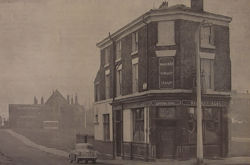 |
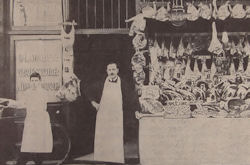 |
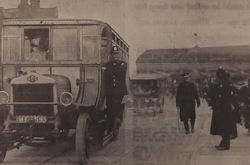 |
The Queens Arms which stood on the corner of Fell Street and Borough Road. The picture was taken in November, 1960, when it was the only property surviving from the tightly packed houses in the area bounded by Borough Road, Fell Street, Abbotsford Street and Church Road. Last orders were called in May 1964. A week later the pub was demolished.
|
This picture, taken in 1908, is of Eastman's butchers, in King Street. 'Splendid', 'Choice', 'Prime' and 'Our Special' read the tags on the joints chops and shoulders. Chops cost sixpence and prime steak was eightpence. Sausages cost threepence a pound. The display of wares stands right out on the pavement and a whole pig hangs by the side of the door. |
'Some stones were thrown, some windows were smashed, but there were few serious incidents here...' That was the Wallasey News reporting on Wallasey and the General Strike of May, 1926. The photograph shows a single-decker motor bus outside Seacombe Ferry with its windows encased in wire mash. A burly constable stands on the running board. |
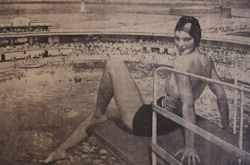 |
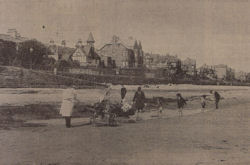 |
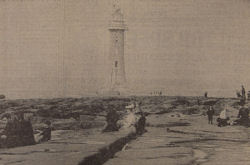 |
This New Brighton famous poster was designed by Septimus Scott in 1935 for the L.M.S Railway. The poster, which was displayed on hundreds of railway stations, was printed in a number of bright colours.
|
These two pictures are by the Victorian photographer, Francis Frith, who produced a definitive collection of views of this country in the late 19th Century. Mr. Frith brought his camera and accompanying paraphernalia to town in the 1890s. He photographed children at play on Egremont sands (left) and picnickers on the rocks around New Brighton Lighthouse (right). His photographs have worn well over one hundred years. The detail is sharp and the composition beautifully balanced.
|
|
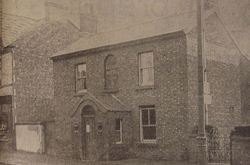 |
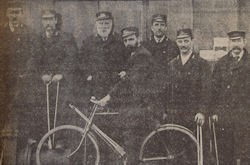 |
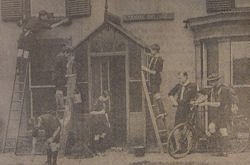 |
Pictured is the old Nelson Hotel in Grove Road. Originally a private house, it was adapted, and by the 1920's look like this. It was demolished to make way for the present 'Nelson' in 1934. Named the 'Nelson' after the family name of Thomas Peers who had the first building up over 140 years ago. He called his pub by it, and the name stuck. |
Seven Edwardian's are lined up before a cameraman in the Wallasey of 1905. They are the Wallasey water Inspectors. In the old days they were a tiny force attached to the local fire brigade, keeping a careful eye on hydrants and wells and pipes. This picture of them probably taken in Mill Lane, where the firemen then had their headquarters. |
A bunch of busy lads are sprucing up the headquarters of their Scout Group, the 8th Wallasey. The date is about 1930. The premises, Orrell Cottage, stood at the corner of Albermarle Road and Liscard Road and was built in the 1700's. The Scouts remained there until 1973. |
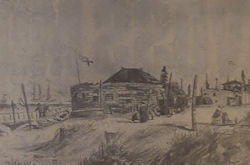 |
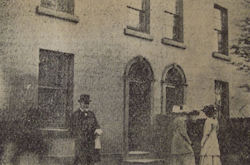 |
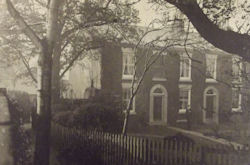 |
Above shows 'The Devil's Nest', a cluster of little shanties and cafes which stood above the New Brighton sands nearly two centuries ago. This is one of the few pictures of it still in existence. They sprang up in the 1830's and were inhabited by a colony of donkey drivers and shore hawkers. The Nest was rather noisy and a rough community. They were cleared about 1871 and replaced by the 'Ham and Eggs Parade'. |
Located at number 87 Seaview Road was the Wallasey Cats Home. The photograph shows Dr. John Oldershaw standing outside the shelter who performed the opening ceremony in May 1910. The Cats Home was set up by Mrs. W.J. Evans and Mrs. Harry May through charitable donations. Cost for having a cat put to death. The home for cats remained until the 1930s. Today the site are motor repairers. |
A lovely photograph of Kirkway Cottages from about 1912. The properties, situated off Kirkway, Upper Brighton, belonged to the Molyneux family, who had their plantation where Molyneux Drive is. The cottages date from 1829. There is a date plate with the initials M (Molyneux) and T.M. There are three terraced houses. No doubt there were previous cottages on the same site. |
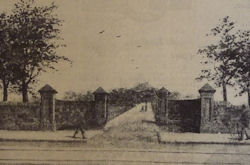 |
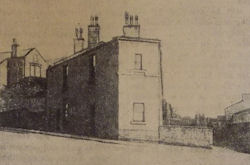 |
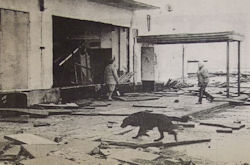 |
These gates were known as Tobin Gates and were in Liscard Road almost opposite the main entrance to the old Liscard Hall in Central Park. A carriage drive led up to Liscard House where Sir John Tobin lived. To the right of the carriage drive were corn fields belonging to Harold Littledale. |
The above is a picture of the Sebastopol Inn which took its name after taking of Sebastopol at the end of the Crimean War in 1855. The Inn and the houses, which were built by Joseph Highton Povall, stood in St. Hilary Brow at its junction with Breck Road, and were demolished in about 1930 to widen the Brow. |
Passers by survey the damage caused by the storms on the night of 26th/27th February 1990 which ripped up sea defences and burst through the open-air pool's rear wall. With costs of £4 million to repair the pool the decision was made to bulldoze the site and by the summer the site was demolished. |
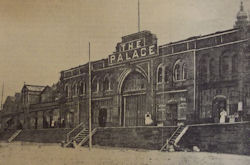 |
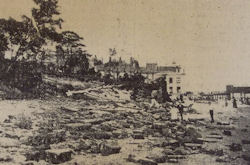 |
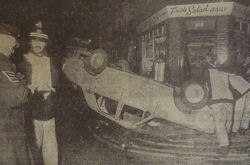 |
This is the Ham & Eggs Parade, taken at its time of its greatest notoriety (c1900). It will be seen that no railings existed to prevent promenades from falling over the edge of the comparatively narrow footway. On many occasions, such as Bank Holidays, when pressure of the crowds forced many people off the promenade and on to the sand. By 1907 this eyesore was demolished and the Floral Pavilion was built on the site in 1913.. |
The picture shows the Plantation before the promenade was built from Egremont to New Brighton and was later known as the Tower Grounds. The rocks below show the condition of the shore along which pedestrians had to walk, before the promenade was built. The house in the background was owned by Misses Molyneux, When she died it was left to Captain Molyneux and on his death the grounds and house was sold to the Tower Company. |
"A man ran off minutes after his car crashed in Poulton Road" read the headline in November 1973. The car, which had been taken from outside Poulton Vics Social Club in Poulton, hit Evans grocery store (No. 168), bounced off, overturned and landed on its roof. As soon as a passerby pulled the driver from the wreckage, he jumped to his feet and ran off before the police arrived on the scene. |
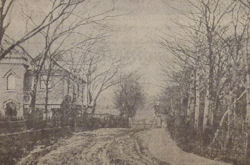 |
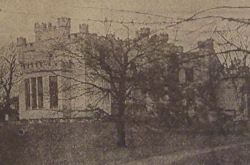 |
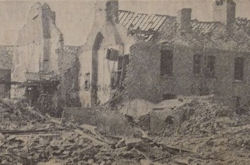 |
The photograph on the left was taken at a time when Wallasey was still little more than a collection of villages and Liscard wore a country air about it. Seaview Road was originally a cart track up to Hoseside Road, where it was closed by a gate and lodging house.. As can be seen from the photograph, it was rough and muddy and pitted with pools of water. There were hedges and trees on either side. In the 1860's Seaview Road was known as Marsden's Lane, after a Liverpool brush manufacturer, Mr John Marsden. James Marsden built Liscard Castle (right). Liscard Castle never was a castle, of course. It was a an eccentric sort of building but its battlements and stone lion embellishments have it a certain stateliness. Some of the locals christened it 'Brush Castle'. Others called it 'Marsden Folly'. The photograph dates back to the 1890's. By that time it had become derelict. In 1902 it was demolished. |
This picture of Lancaster Avenue after some of the heavy air raids of 1941, shows how badly Wallasey suffered during the Luftwaffe's onslaught. It was here, on the night of 12th, March, that a German land mine landed on Lancaster Avenue. At that time there brick air-raid shelters which were built in the middle of the road. Many were killed. Whilst searching for survivors three-month old baby Irene Foulds was found under the debris by rescue workers some three and a half days after the air-raid. |
|
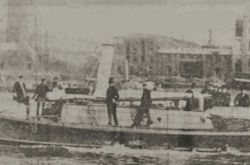 |
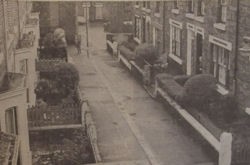 |
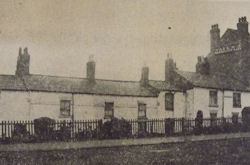 |
This is the steam lifeboat 'Queen' which was stationed at New Brighton from 1897-1924, during which she saved 196 lives. She was replaced by the motor lifeboat 'William and Kate Johnson', which saved 248 lives during her 26 years of service. The Lifeboat Service was officially founded by Sir William Hillary at Douglas, Isle of Man, in 1824. It soon became a national institution with New Brighton establishing a station in 1863 (there had been an earlier station at the Magazines since the 1820's).. |
Tucked away in a quiet corner of New Brighton was, The Avenue, off Egerton Street, which was a little community. There were 13 houses that were built about 1830 and were homes for lighthouse keepers.. By the 1970's the Council wanted the houses demolished, calling them "grim" became of the damp conditions which made the properties inhabitable. A compulsory purchase order was confirmed in 1975 and the houses were all cleared.. |
Marine Parade once stood next to the public house at the corner of Birkenhead Road, just opposite the ferry car park. They were demolished in the early 1930's. At one time the tide would come up to the road. Women living in the cottages use to throw broken crockery into the water which were all covered up when the approaches were filled in. When the floating roadway was made they unearthed all the broken crockery and a great controversy arose as to how it had originated. |
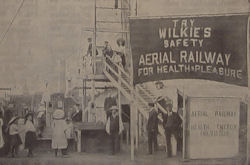 |
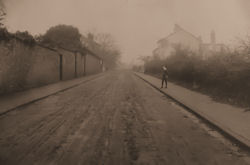 |
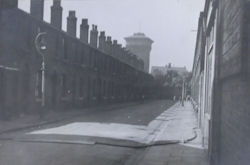 |
Mr Wilkie's "safety aerial railway for health and pleasure" was photographed at New Brighton in the mid 1890's. In the big white hat and shirt sleeves, watch chain across his chest, is George Wilkie, the founder of the company. New Brighton was on the brink of great things when this picture was taken. The ferryboats to the resort were packed every day of the long, hot summers. The pier and its pavilion did boom business. |
A lovely old picture of Seaview Road from the 1890's with Liscard behind the photographer. Burns Avenue is top left. Standing on the top right is the white building 'Rose Cottage' which still stands today almost opposite Burns Avenue. it was once the home of Charles Hesketh Hill who was a member of the Wallasey Local Board for many years. the house was used for many years by Woods Motors.. |
A 1939 view of Rossett Place which was located off Liscard Road. Mill Lane Water Tower can be seen in the distance. They were all demolished in the late 1960s to make way for the Cherry Tree Shopping Centre. The entrance to the street was where Primark is today. Various tenants living here included labourers, painters, gardeners, bus drivers and postmen |